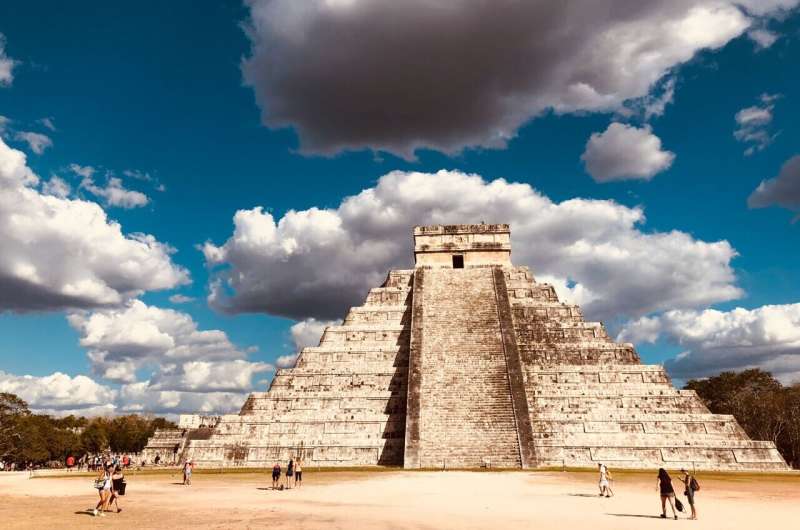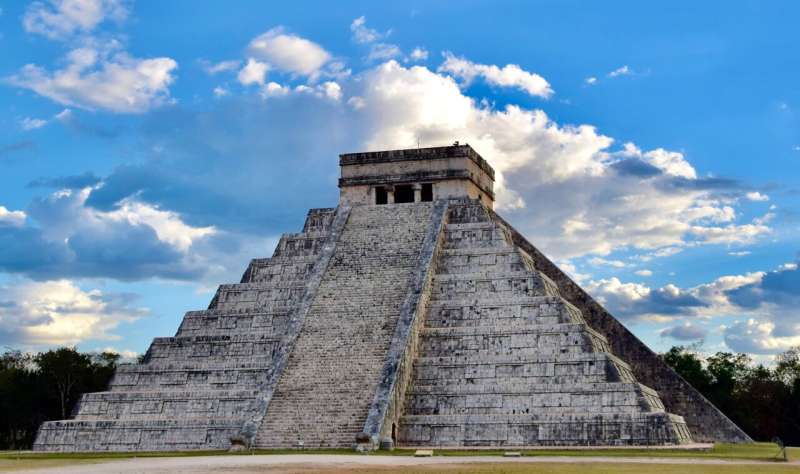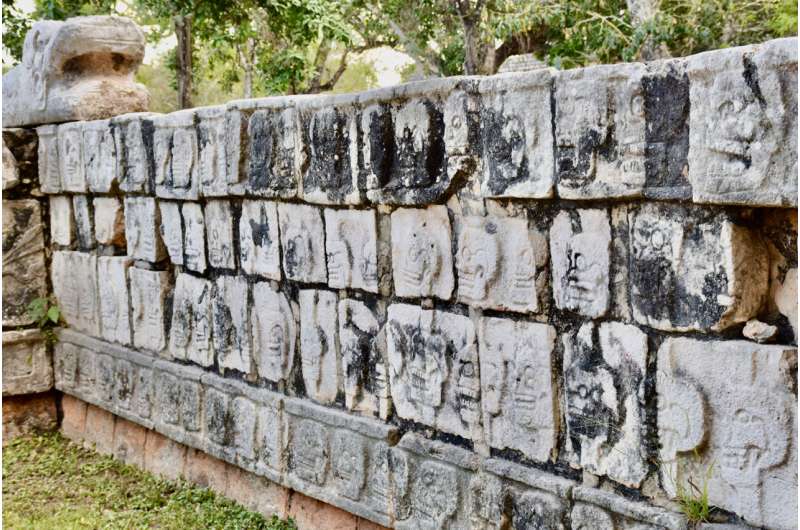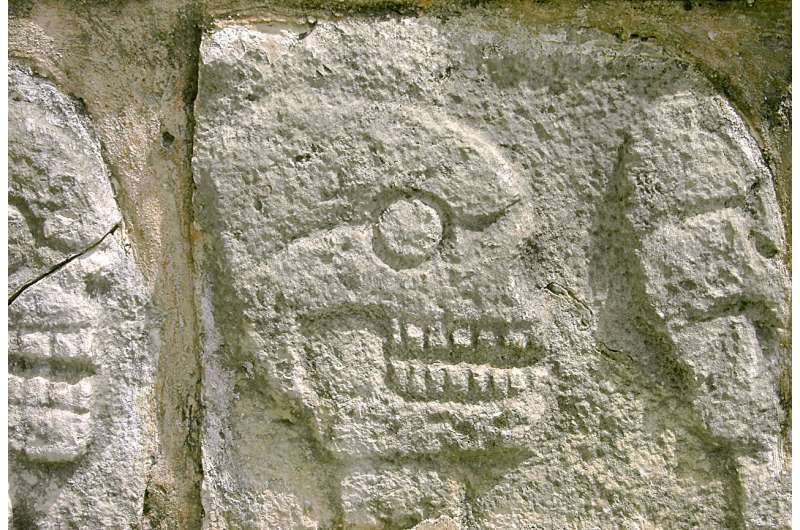This article has been reviewed according to Science X's editorial process and policies. Editors have highlighted the following attributes while ensuring the content's credibility:
fact-checked
peer-reviewed publication
trusted source
proofread
Ancient Maya genomes reveal the practice of male twin ritual sacrifice at Chichén Itzá

Rising to power in the wake of the Classic Maya collapse, Chichén Itzá was among the largest and most influential cities of the ancient Maya, but much about its political connections and ritual life remain poorly understood.
In a study in Nature, researchers discover a practice of ritual child sacrifice focused exclusively on males. Close kin relationships, including two pairs of identical twins, suggest a connection to the Maya origin myths of the Popol Vuh. Further comparison to Maya populations today reveals the genetic impact of colonial-era epidemics.
Located in the heart of Mexico's Yucatan peninsula, the ancient Maya city of Chichén Itzá is one of South America's most iconic and enigmatic archaeological sites. It rose to power in the aftermath of the Classic Maya collapse and was a populous and powerful political center in the centuries preceding the arrival of the Spanish.
Chichén Itzá's influence extended throughout the Maya region and deep into the heart of Central Mexico. Famed for its monumental architecture, including more than a dozen ball-courts and numerous temples, among them the massive temple of El Castillo adorned with feathered serpents, it has been under archaeological investigation for more than a century.
Chichén Itzá is perhaps best known for its extensive evidence of ritual killing, which includes both the physical remains of sacrificed individuals and representations in monumental art.
The controversial dredging of the site's Sacred Cenote in the early 20th century identified the remains of hundreds of individuals, and a full-scale stone representation of a massive tzompantli (skull rack) in the site's core points to the centrality of sacrifice within the ritual life at Chichén Itzá. Despite its notoriety, however, the role and context of ritual killing at the site remain poorly understood.
A large proportion of sacrificed individuals at the site are children and adolescents. Although there is a widespread belief that females were the primary focus of sacrifice at the site, sex is difficult to determine from juvenile skeletal remains by physical examination alone, and more recent anatomical analyses suggest that many of the older juveniles may in fact be male.
In 1967, a subterranean chamber was discovered near the Sacred Cenote that contained the scattered remains of more than a hundred young children. The chamber, which was likely a repurposed chultún (water cistern), had been enlarged to connect to a small cave. Among the ancient Maya, caves, cenotes (natural sinkholes), and chultúns have long been associated with child sacrifice, and such subterranean features were widely viewed as connection points to the underworld.
To better understand ritual life and the context of child sacrifice at Chichén Itzá, an international team of researchers from institutions including the Max Planck Institutes for Evolutionary Anthropology (MPI-EVA, Leipzig) and Geoanthropology (MPI-GEA, Jena), the National School of Anthropology and History (ENAH, Mexico City), the National Institute of Anthropology and History (INAH-Yucatan, Mérida), and Harvard University (Cambridge) conducted an in-depth genetic investigation of the remains of 64 children ritually interred within the chutún at Chichén Itzá.

A ritual sacrifice focused on males and close kin
Dating of the remains revealed that the chultún was used for mortuary purposes for more than 500 years, from the 7th to 12th centuries AD, but that most of the children were interred during the 200-year period of Chichén Itzá's political apex between 800 to 1,000 AD.
Unexpectedly, genetic analysis revealed that all 64 tested individuals were male. Further genetic analysis revealed that the children had been drawn from local Maya populations, and that at least a quarter of the children were closely related to at least one other child in the chultún. These young relatives had consumed similar diets, suggesting they were raised in the same household.
"Our findings showcase remarkably similar dietary patterns among individuals exhibiting a first- or second-degree familial connection," says co-author Patxi Pérez-Ramallo, postdoctoral researcher at the Department of Archaeology and Cultural History, NTNU University Museum, Trondheim, Norway and the MPI-GEA.
"Most surprisingly, we identified two pairs of identical twins," says Kathrin Nägele, co-author and group leader at the MPI-EVA. "We can say this with certainty because our sampling strategy ensured we would not duplicate individuals."
Taken together, the findings indicate that related male children were likely being selected in pairs for ritual activities associated with the chultún.
"The similar ages and diets of the male children, their close genetic relatedness, and the fact that they were interred in the same place for more than 200 years point to the chultún as a post-sacrificial burial site, with the sacrificed individuals having been selected for a specific reason," says Oana Del Castillo-Chávez, co-author and researcher in the Physical Anthropology Section at the Centro INAH Yucatán.

Connections to the Popol Vuh
Twins hold a special place in the origin stories and spiritual life of the ancient Maya. Twin sacrifice is a central theme in the sacred K'iche' Mayan Book of Council, known as the Popol Vuh, a colonial-era book whose antecedents can be traced back more than 2,000 years in the Maya region.
In the Popol Vuh, the twins Hun Hunahpu and Vucub Hunahpu descend into the underworld and are sacrificed by the gods following defeat in a ballgame. The twin sons of Hun Hunahpu, known as the Hero Twins Hunahpu and Xbalanque, then go on to avenge their father and uncle by undergoing repeated cycles of sacrifice and resurrection in order to outwit the gods of the underworld.
The Hero Twins and their adventures are amply represented in Classic Maya art, and because subterranean structures were viewed as entrances to the underworld, the interment of twins and pairs of close kin within the chultún at Chichén Itzá may recall rituals involving the Hero Twins.
"Early 20th century accounts falsely popularized lurid tales of young women and girls being sacrificed at the site," says Christina Warinner, John L. Loeb Associate Professor of the Social Sciences and Anthropology at Harvard University and a group leader at the MPI-EVA.
"This study, conducted as a close international collaboration, turns that story on its head and reveals the deep connections between ritual sacrifice and the cycles of human death and rebirth described in sacred Maya texts."

The enduring genetic legacy of colonial epidemics
The detailed genetic information obtained at Chichén Itzá has also allowed researchers to investigate another major outstanding question in Mesoamerica: the long-term genetic impact of colonial-era epidemics on Indigenous populations.
Working closely with residents of the local Maya community of Tixcacaltuyub, researchers found evidence of genetic positive selection in immunity-related genes, and specifically selection for genetic variants that are protective against Salmonella infection.
During the 16th century in Mexico, wars, famines, and epidemics caused a population decline as high as 90 percent, and among the most serious epidemics was the 1545 cocoliztli epidemic, recently identified as being caused by the pathogen Salmonella enterica Paratyphi C.
"The present-day Maya carry the genetic scars of these colonial-era epidemics," says lead author Rodrigo Barquera, immunogeneticist and postdoctoral researcher at the MPI-EVA.
"Multiple lines of evidence point to specific genetic changes in the immune genes of present-day Mexicans of Indigenous and mixed-ancestry descent that are linked to enhanced resistance to Salmonella enterica infection."
The study of ancient DNA is increasingly allowing more detailed and complex questions to be asked about the past. "The new information gained from ancient DNA has not only allowed us to dispel outdated hypotheses and assumptions and to gain new insights into the biological consequences of past events, it has given us a glimpse into the cultural lives of the ancient Maya," says senior author Johannes Krause, Director of the Department of Archaeogenetics at the MPI-EVA.
Such studies also empower Indigenous researchers to shape narratives of the past and set priorities for the future.
"It is significant to me as a research professor of indigenous origin that I can contribute to the construction of knowledge," says María Ermila Moo-Mezeta, Mayan co-author of the study and researcher at the Autonomous University of Yucatán (UADY). "I consider the preservation of the historical memory of the Mayan people to be important."
More information: Rodrigo Barquera et al, Ancient genomes reveal insights into ritual life at Chichén Itzá, Nature (2024). DOI: 10.1038/s41586-024-07509-7. www.nature.com/articles/s41586-024-07509-7
Journal information: Nature
Provided by Max Planck Society




















